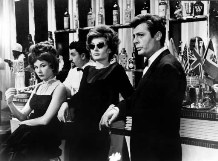 Federico Fellini saw the world through the eyes of mythology. That is perhaps the secret of his appeal: as specific as his scenes and characters are, they deepen into archetypes as we watch. After gaining critical acclaim with six groundbreaking films in the 1950s, Fellini was ready to paint on a larger canvas, and the result was a film, released in 1960, that foretold the excitement and cultural turbulence of the coming decade. La Dolce Vita, “The Sweet Life” was a film of exuberance and excess, a movie that startled the world.
Federico Fellini saw the world through the eyes of mythology. That is perhaps the secret of his appeal: as specific as his scenes and characters are, they deepen into archetypes as we watch. After gaining critical acclaim with six groundbreaking films in the 1950s, Fellini was ready to paint on a larger canvas, and the result was a film, released in 1960, that foretold the excitement and cultural turbulence of the coming decade. La Dolce Vita, “The Sweet Life” was a film of exuberance and excess, a movie that startled the world.
It opens with a huge statue of Christ suspended from a helicopter as it flies towards the Vatican. The contrast between the age-old heritage of faith and the loud and bewildering modern world is perfectly contained in this one image. Recording the event from another helicopter is Marcello, a gossip columnist played by Marcello Mastrioanni. For the rest of the film we follow him as he wanders through parties, nightclubs, and other scenes of decadence; having encounters with various women, including prostitutes; and famously escorting an American starlet, played by Anita Ekberg, through the streets of Rome at night. Other episodes in this swirling pattern of a film include a crowd gathering around two children who claim to have seen the Virgin Mary in a field, and a later visit to Marcello’s friend Steiner at a cocktail party that ruthlessly satirizes the weakness and passivity of intellectuals.
Behind the frenzied search for more pleasure and excitement there is depression; and behind that, we find tragedy. To which Marcello responds by plunging into even more debauchery. Yet it is not the series of events as portrayed here that captures one’s mind—it is Fellini’s style, colorful and vigorous even when the feelings are most dark. There are many themes flowing into and mirroring one another in the film. Among the most striking is that of woman as object: the object of male idealism, fantasy and projection, desire and revulsion. To Marcello, the world is like a woman before whose beauty he feels helpless and alone.
It’s amazing how Fellini can touch a chord of sadness in the midst of such excess. This is a long film, almost three hours, and we the viewers may feel like travelers on a seemingly endless and mysterious journey, like Dante or Ulysses. In its depiction of an increasing quest for sensation, coupled with a sense of spiritual loss, La Dolce Vita seems to predict the entire cultural arc of the 1960s, when the energies of youth were let loose, and to an unforeseen end.

